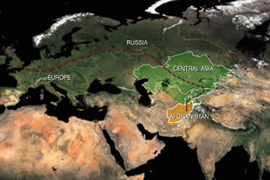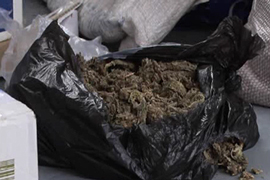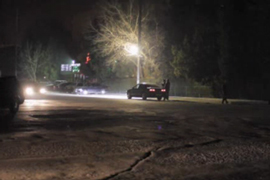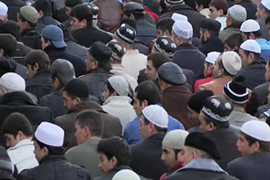
Aids on the heroin road
People & Power investigates the spread of HIV in Central Asia.
When Nato and its allies went to war in Afghanistan, the alliance promised to curtail the export of drugs to Europe.
Since then, the West has spent hundreds of millions of dollars setting up local agencies to fight drug trafficking, not just in Afghanistan but also along the main opium and heroin route through the former Soviet republics of Central Asia.
As filmmaker Michael Andersen reports, the region is now facing another danger, a potential epidemic of HIV infections.
Madina is four years old. Her mother took her to a hospital one year ago because she was running a fever. Like many hospitals in Central Asia, this one too was sorely strapped for supplies.
Although Madina’s mother paid for a fresh needle, the one that was used on her was not and she got infected with the HIV virus.
In 2008, about 170 children in Kyrgyzstan were infected in the same manner and there are similar cases throughout Central Asia. Fourteen doctors were fired – but nobody was indicted and families are still waiting for compensation.
“I didn’t know that this disease even existed in Kyrgyzstan. I brought my daughter to the hospital, because she had pneumonia. I think she caught the virus from an IV drip which they put in her arm. I saw the nurses use the same syringe for several children,” Dinara, Manira’s mother, said.
“My husband did not understand this illness. When our daughter was diagnosed, he left me,” the mother of another infected child says.
“People here think we are to blame, that the illness is caused by the mothers not behaving properly.”
Poverty
 |
| The drugs are smuggled from Afghanistan through Central Asia and Russia to Europe |
The fate of the children has resulted from poverty and a lack of information, but also geography: These children live on a modern day version of the silk road – the route that the heroin and opium now travel – from producers in Afghanistan to buyers in Europe.
“It is a fact that HIV spreads in the wake of drugs in Central Asia, so the places where drugs are smuggled, that’s where you find the HIVs.
“The drugs go all the way through Afghanistan, through Tajikistan, through the rest of Central Asia which is a hub for drug smuggling, further on to Russia and to Europe,” Pia Dyrhagen of Dan Church Aid in Kyrgyzstan said.
However, Central Asian governments tend to ignore – even suppress – information about HIV. Officially, only two persons per 1,000 are infected with the virus.
“Experts say you can easily multiply that number with up to 10 and then you get the actual number of HIV infected, meaning actually more than two per cent of the population could be HIV infected,” Dyrhagen said.
Two to three per cent infected among 50 million means that there is potentially one million people with HIV.
Dyrhagen said: “The last 10 years maybe 15 years since HIV broke out in the region it was limited to risk groups. Limited to injecting drug users, to comercial sex workers, to men having sex with men, but what you see these years is that it’s bridging to the general population.
“It’s bridging through women having sexual relations with injecting drug users, it’s labour migrants coming back from Russia where the HIV prevalence is higher, and you also have these cases of children getting infected in hospitals. Combined with a quite low level of awareness of HIV and how to protect yourself, this is like a bomb.”
Local drug agencies
 |
| The UN says that Central Asia’s drug control agencies seize two per cent of the drugs |
In order to stop the drugs coming from Afghanistan through Central Asia to Europe, the West has spent tens of millions of dollars setting up local drug control agencies.
Stopping the drugs at source was one of Nato’s justifications for the war in Afghanistan.
But so far, with very limited success.
According to the United Nations six million doses of heroin enter Tajikistan every day, and the government agencies in Central Asia seize only two per cent of the drugs travelling through the region.
Khushnud Rakhmatullaev, the spokesman for the Tajik border police, said it was fairly easy to cross the 1,300 km border with Afghanistan.
“Our border guards are patrolling on foot. Sometimes they have to walk 20-30km a day, and they’re only young kids. I would estimate that we confiscate maybe 10 or 12 per cent of the drugs which are smuggled into Tajikistan.
“Tajikistan is just a transit country. Most of the drugs just pass through our region and go on to destroy somebody’s life in Russia, Europe or the America,” he said.
Entangled in criminal networks
The responsible UN agency believes that another problem is also significant. “The police have themselves become closely entangled in criminal networks engaged in contraband and drugs trafficking,” the UN Office on Drugs and Crime (UNODC) reports.
As we travelled further along the drugs route, this view was supported. Although the police would not speak to us, some drug users alleged police involvement in the drugs trade.
“If you’re a new face round here, trying to buy drugs, the police will arrest you in a second. They will arrest you, so that they can come to an ‘agreement’ with you. Get a bribe from you. You pay them and they let you go. Without the police there would be no drugs here,” one former addict in a drop-in centre for recovering drug addicts in Khujand said.
Another addict said: “They say that there are no drugs in the prisons. Officially there are no drugs in the prisons here. But practically in all prisons there are drugs.
“But how can the drugs get in when they are heavily guarded and allow no visitors. The only explanation is that the police bring it in. This is a simple proof that the police themselves are involved in drug dealing. Where I was in prison, 80 per cent were drug addicts.”
The UN estimates that there are almost half a million drug addicts in Central Asia, the huge majority injecting heroine. Experts warn that it is a particular worry here in Central Asia that addicts often share needles.
“Sometime you don’t have a choice. You’re sitting there in the prison and there’s only one needle. And that needle will be used by 50 or 100 people in one day.”
In Osh, in southern Kyrgyzstan, we had agreed an interview at the drugs control agency. But when we arrived, the agency had been closed down by the Kyrgyz president – no official reason was given.
As a result, Kyrgyzstan, a key point on the drugs and HIV trail, is now left without a special agency for combating the drugs trade.
Lack of information
 |
| Prostitution plays an important role in the spread of HIV in Central Asia |
Often drug addiction drives women into prostitution. In Osh – a town with half a million people – and maybe as many as 10,000 drug addicts, there are now more than 1,000 commercial sex workers.
The organisation, ‘Podruga’, runs information sessions for them about the importance of using condoms.
Prostitution is a key factor in the spread of HIV. Nevertheless, many men here will pay double the fee for sex without a condom.
According to experts the lack of information is one of biggest problems when trying to combat Aids in Central Asia.
“One thing that is still a taboo here, is the use of condoms. And if you start talking about condoms, it implies that you are not faithful to your partner, that you have other partners,” Dyrhagen said.
“We made a survey, of the population in the southern regions, where HIV is most widespread, showing that 30 per cent of the respondents said that they didn’t believe that condoms prevented HIV.”
With poverty forcing millions of young men from Central Asia to go and work in Russia, many come back with more than just money.
“We have numbers on HIV prevalence among commercial sex workers, street prostitutes, in St. Petersburg in Russia, that 92 per cent of the street prostitutes are injecting drug users, and 50 per cent of them are HIV positive. These are the cheapest prostitutes, prostitutes on the street, and those are the ones that Tajik, Kyrgyz, whatever, labour migrants would go to.
“This is what is happening, Central Asia labour migrants will go to prostitutes, in Russia, without using condoms, getting infected, coming back to their family, wife, etc. in Central Asia, and of course transfer the HIV to them,” Dyrhagen said.
Imams inform about HIV
 |
| Some Tajik imams started raising issues like drugs and the spread of HIV in the mosque |
This situation has now convinced a group of 30 imams in Tajikistan to bring information about HIV into the mosque.
It was Manizha Haitova, the director of the Centre of Mental Health and HIV/Aids Takikistan, who came up with this unique project which is supported by Christian aid organisations.
“The imams and Islam, this is the only way, the only instruments for influence, deep influence to the people.
“In the Muslim society using condoms can only be between wife and husband.
“After our training, our participants, the imams, they provide information that if you have some behaviour, risky behaviour, abroad from the country, you should use condoms with your wife,” Manizha says.
Before the Friday prayer, a leading imam told us about his participation in the project. The imams are now mentioning condoms in their services, but most are still more keen on stressing abstinence and monogamy.
“Our responsibility is to warn our congregations against using drugs and having improper sexual relations. The only guarantee is to live by Sharia law, and by the law given by God in the Quran, in the Torah and in the Bible.
“Using condoms is one way of avoiding the disease, but a condom can break. There is a Tajik saying: if you do not want to be bitten by a mad dog, just do not go close to any mad dogs,” Abdulbasir Saidov, the imam of Shomansur mosque, said.
Aids on the heroin road aired from Wednesday, March 24, 2010.